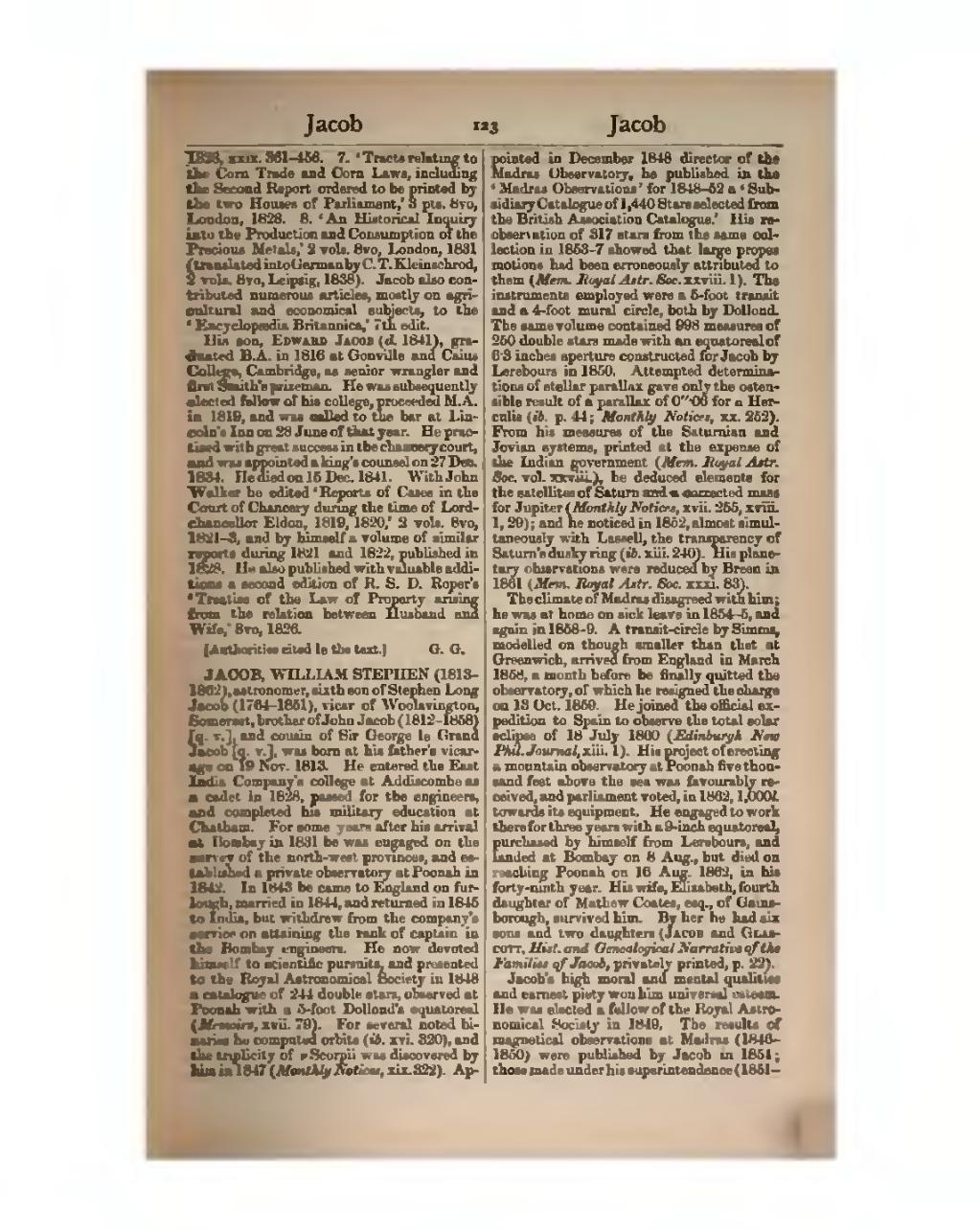- 1828, xxix. 361–456.
- ‘Tracts relating to the Corn Trade and Corn Laws, including the Second Report ordered to be printed by the two Houses of Parliament,’ 3 pts. 8vo, London, 1828.
- ‘An Historical Inquiry into the Production and Consumption of the Precious Metals,’ 2 vols. 8vo, London, 1831 (translated into German by C. T. Kleinschrod, 2 vols. 8vo, Leipzig, 1838).
Jacob also contributed numerous articles, mostly on agricultural and economical subjects, to the ‘Encyclopædia Britannica,’ 7th edit.
His son, Edward Jacob (d. 1841), graduated B.A. in 1816 at Gonville and Caius College, Cambridge, as senior wrangler and first Smith's prizeman. He was subsequently elected fellow of his college, proceeded M.A. in 1819, and was called to the bar at Lincoln's Inn on 28 June of that year. He practised with great success in the chancery court, and was appointed a king's counsel on 27 Dec. 1834. He died on 15 Dec. 1841. With John Walker he edited ‘Reports of Cases in the Court of Chancery during the time of Lord-chancellor Eldon, 1819, 1820,’ 2 vols. 8vo, 1821–3, and by himself a volume of similar reports during 1821 and 1822, published in 1828. He also published with valuable additions a second edition of R. S. D. Roper's ‘Treatise of the Law of Property arising from the relation between Husband and Wife,’ 8vo, 1826.
[Authorities cited in the text.]
JACOB, WILLIAM STEPHEN (1813–1862), astronomer, sixth son of Stephen Long Jacob (1764–1851), vicar of Woolavington, Somerset, brother of John Jacob (1812–1858) [q. v.], and cousin of Sir George le Grand Jacob [q. v.], was born at his father's vicarage on 19 Nov. 1813. He entered the East India Company's college at Addiscombe as a cadet in 1828, passed for the engineers, and completed his military education at Chatham. For some years after his arrival at Bombay in 1831 he was engaged on the survey of the north-west provinces, and established a private observatory at Poonah in 1842. In 1843 he came to England on furlough, married in 1844, and returned in 1845 to India, but withdrew from the company's service on attaining the rank of captain in the Bombay engineers. He now devoted himself to scientific pursuits, and presented to the Royal Astronomical Society in 1848 a catalogue of 244 double stars, observed at Poonah with a 5-foot Dollond's equatoreal (Memoirs, xvii. 79). For several noted binaries he computed orbits (ib. xvi. 320), and the triplicity of v Scorpii was discovered by him in 1847 (Monthly Notices, xix. 322). Appointed in December 1848 director of the Madras Observatory, he published in the ‘Madras Observations’ for 1848–52 a ‘Subsidiary Catalogue of 1,440 Stars selected from the British Association Catalogue.’ His re-observation of 317 stars from the same collection in 1853–7 showed that large proper motions had been erroneously attributed to them (Mem. Royal Astr. Soc. xxviii. 1). The instruments employed were a 5-foot transit and a 4-foot mural circle, both by Dollond. The same volume contained 998 measures of 250 double stars made with an equatoreal of 6.3 inches aperture constructed for Jacob by Lerebours in 1850. Attempted determinations of stellar parallax gave only the ostensible result of a parallax of 0″.06 for α Herculis (ib. p. 44; Monthly Notices, xx. 252). From his measures of the Saturnian and Jovian systems, printed at the expense of the Indian government (Mem. Royal Astr. Soc. vol. xxviii.), he deduced elements for the satellites of Saturn and a corrected mass for Jupiter (Monthly Notices, xvii. 255, xviii. 1, 29); and he noticed in 1852, almost simultaneously with Lassell, the transparency of Saturn's dusky ring (ib. xiii. 240). His planetary observations were reduced by Breen in 1861 (Mem. Royal Astr. Soc. xxxi. 83).
The climate of Madras disagreed with him; he was at home on sick leave in 1854–5, and again in 1858–9. A transit-circle by Simms, modelled on though smaller than that at Greenwich, arrived from England in March 1858, a month before he finally quitted the observatory, of which he resigned the charge on 13 Oct. 1859. He joined the official expedition to Spain to observe the total solar eclipse of 18 July 1860 (Edinburgh New Phil. Journal, xiii. 1). His project of erecting a mountain observatory at Poonah five thousand feet above the sea was favourably received, and parliament voted, in 1862, 1,000l. towards its equipment. He engaged to work there for three years with a 9-inch equatoreal, purchased by himself from Lerebours, and landed at Bombay on 8 Aug., but died on reaching Poonah on 16 Aug. 1862, in his forty-ninth year. His wife, Elizabeth, fourth daughter of Mathew Coates, esq., of Gainsborough, survived him. By her he had six sons and two daughters (Jacob and Glascott, Hist. and Genealogical Narrative of the Families of Jacob, privately printed, p. 22).
Jacob's high moral and mental qualities and earnest piety won him universal esteem. He was elected a fellow of the Royal Astronomical Society in 1849. The results of magnetical observations at Madras (1846–1850) were published by Jacob in 1854; those made under his superintendence (1851–
